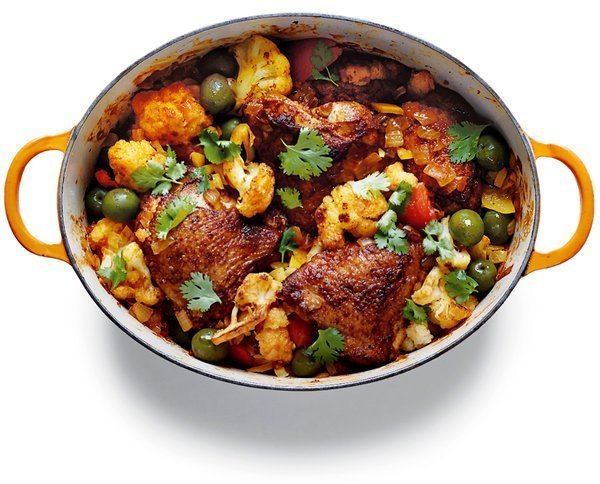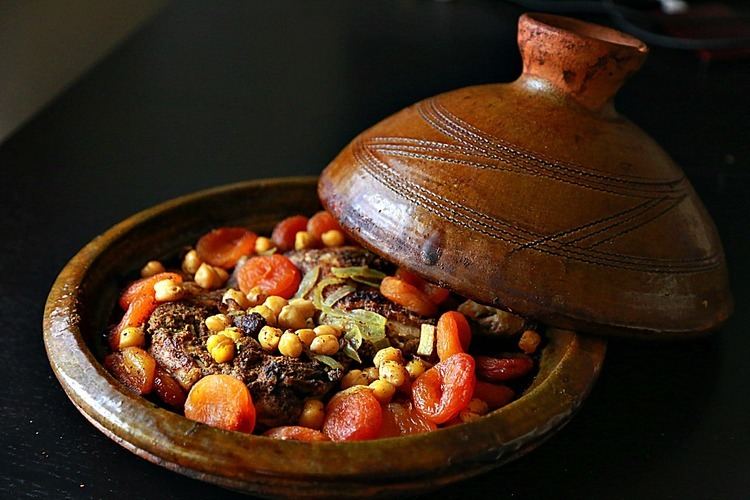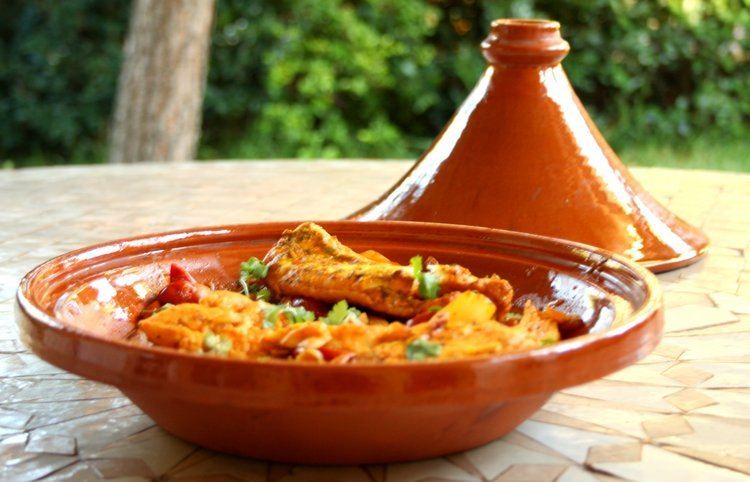 | ||
Food energy(per serving) 1,110 kJ (265 kcal) kcal Other information Dietary fiber 8 g, sugars 0 g, protein 14 g, total carbohydrate 45 g Similar Couscous, Pastilla, Kofta, Harira, Ras el hanout | ||
Tajine poulet et legumes chicken tagine and veggies
Tajine or tagine (Berber: ⵜⴰⵊⵉⵏ, Tajin) is a North African Berber dish which is named after the earthenware pot in which it is cooked.
Contents
- Tajine poulet et legumes chicken tagine and veggies
- Authentic moroccan tajine w spices shay s kitchen
- Origin
- Etymology
- Pottery
- Moroccan and Algerian tajines
- Tunisian tajine
- Other
- References

Authentic moroccan tajine w spices shay s kitchen
Origin

Historically Tagine is an ancient originally Berber dish, is a succulent stew made of meats and vegetables and traditionally cooked in a conical clay pot to allow the steam to rise, condense and drip back down to the stew. The traditional method of cooking is to place the tagine over coals, and typically the dish includes meat, chicken or fish, and most often vegetables or fruit. Because this meal takes a long time to prepare, the woman of the house starts preparing the lunch tagine as soon as breakfast is over.
Etymology
There are several theories on the origin of the word tajine:

Pottery

The traditional tajine pottery, sometimes painted or glazed, consists of two parts: a circular base unit that is flat with low sides and a large cone- or dome-shaped cover that sits on the base during cooking. The cover is designed to return all condensation to the bottom.
Tajine is traditionally cooked over hot charcoal leaving an adequate space between the coals and the tajine pot to avoid having the temperature rise too quickly. Large bricks of charcoal are used, specifically for their ability to stay hot for hours. Other methods are to use a tajine in a slow oven or on a gas or electric stove top, on the lowest heat necessary to keep the stew simmering gently. A diffuser, a circular utensil placed between the tajine and the flame, is used to evenly distribute the stove's heat. European manufacturers have created tajines with heavy cast-iron bottoms that can be heated on a cooking stove to a high temperature, which permits the browning of meat and vegetables before cooking.
Tajine cooking may be replicated by using a slow cooker or similar item, but the result will be slightly different. Many ceramic tajines are decorative items as well as functional cooking vessels. Some tajines, however, are intended only to be used as decorative serving dishes.
Moroccan and Algerian tajines
Moroccan and Algerian tajine dishes are slow-cooked savory stews, typically made with sliced meat, poultry or fish together with vegetables or fruit. Spices, nuts, and dried fruits are also used. Common spices include ginger, cumin, turmeric, cinnamon, and saffron. Paprika and chili are used in vegetable tajines. The sweet and sour combination is common in tajine dishes like lamb with dates and spices. Tajines are generally served with bread. Because the domed or cone-shaped lid of the tajine pot traps steam and returns the condensed liquid to the pot, a minimal amount of water is needed to cook meats and vegetables. This method of cooking is practical in areas where water supplies are limited or where public water is not yet available.
Tunisian tajine
What Tunisians refer to as a "tajine" is very different from the Moroccan dish. Tunisian tajine is more like an Italian frittata or an eggah. First, a simple ragout is prepared, of meat cut into very small pieces, cooked with onions and spices, such as a blend of dried rosebuds and ground cinnamon known as baharat or a robust combination of ground coriander and caraway seeds; this is called tabil. Then something starchy is added to thicken the juices. Common thickeners include cannellini beans, chickpeas, breadcrumbs or cubed potatoes. When the meat is tender, it is combined with the ingredients which have been chosen to be the dominant flavouring. Examples include fresh parsley, dried mint, saffron, sun-dried tomatoes, cooked vegetables and stewed calves' brains. Next, the stew is enriched with cheese and eggs. Finally, this egg and stew is baked in a deep pie dish, either on the stove or in the oven until top and bottom are crisply cooked and the eggs are just set. When the tajine is ready, it is turned out onto a plate and sliced into squares, accompanied by wedges of lemon. Tunisian tajines can also be made with seafood or as a completely vegetarian dish.
In rural parts of Tunisia, home cooks place a shallow earthenware dish over olive-wood coals, fill it, cover it with a flat earthenware pan, and then pile hot coals on top. The resulting tajine is crusty on top and bottom, moist within and is infused with a subtle smoky fragrance.
Other
A similar dish known as tavvas is found in Cypriot cuisine.
